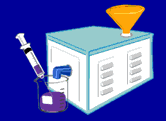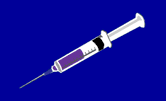
Step 1
Use the tweezers to pull out a segment of DNA from the
hepatitis B virus.
|
|
A subunit vaccine makes use of just a small portion of a
pathogen. For a virus, the vaccine can contain just a piece of
the protein coat that surrounds the virus's DNA (or RNA). Even
small portion of a virus is sometimes enough to stimulate an
immune response in the body.
There are several ways to produce a vaccine for hepatitis B
vaccine. For your vaccine, you'll use genetic engineering
techniques.
|

Step 2
Add the segment of DNA to the DNA of a yeast cell (which is in
the yeast culture).
|
|
A segment of the virus's DNA is responsible for the production
of the virus's protein coat. You will add this segment to the
DNA within a yeast cell.
The yeast cell, as it grows, will "read" the viral DNA
incorporated in its own DNA and produce the protein that makes
up the protein coat of hepatitis B.
|

Step 3
Use the purifier to isolate the hepatitis B antigen produced
by the yeast cells.
|
|
The vaccine, once administered, will stimulate the immune
system to attack the antigen (i.e., the protein coat). Then,
if the inoculated person is later exposed to the virus, the
immune system will quickly respond to the invader and
eliminate it before it has a chance to spread widely.
To finish making the vaccine, you need to separate the
proteins from the yeast cells.
|

Step 4
Fill the syringe with the purified hepatitis B antigen.
|
|
The isolated hepatitis B protein, produced by the yeast cells,
contains none of the viral DNA that makes hepatitis B harmful.
Therefore, there is no possibility of it causing the disease.
|

Done
The hepatitis B vaccine is complete.
Select another pathogen.
|
|
Congratulations. You have produced a subunit vaccine for
hepatitis B.
Another example in the subunit category is the anthrax vaccine
approved in the U.S. (The countries of the former Soviet Union
have an attenuated version of the vaccine.) The U.S. vaccine
is currently administered to military personnel.
|

